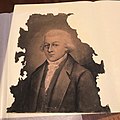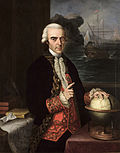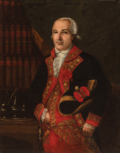List
French Louisiana (1682–1762)
| # | Portrait | Name (Birth–Death) | Took office | Left office |
|---|---|---|---|---|
| 1 |  | Sauvolle (1671–1701) | 1699 | 1701 (Died in office) |
| 2 |  | Jean-Baptiste Le Moyne de Bienville (1680–1767) | 1701 | 1713 |
| 3 |  | Antoine de la Mothe Cadillac (1658–1730) | 1713 | 1716 |
| 4 |  | Jean-Baptiste Le Moyne de Bienville (1680–1767) | 1716 | 1717 |
| 5 |  | Jean-Michel de Lepinay (c. 1665–1721) | 1717 | 1718 |
| 6 |  | Jean-Baptiste Le Moyne de Bienville (1680–1767) | 1718 | 1724 |
| 7 |  | Pierre Dugué de Boisbriand (1675–1736) | 1724 | 1726 |
| 8 |  | Étienne Perier (1686–1766) | 1726 | 1733 |
| 9 |  | Jean-Baptiste Le Moyne de Bienville (1680–1767) | 1733 | 1743 |
| 10 |  | Pierre de Rigaud de Vaudreuil-Cavagnial (1698–1778) | 1743 | 1753 |
| 11 |  | Louis Billouart (1704–1770) | 1753 | 1763 |
| 12 |  | Jean-Jacques Blaise d'Abbadie (1726–1765) | 1763 | 1765 (Died in office) |
| 13 |  | Charles Philippe Aubry (c. 1720–1770) | 1765 | 1768 |
Spanish Louisiana (1762–1803)
| # | Portrait | Name (Birth–Death) | Took office | Left office |
|---|---|---|---|---|
| 1 |  | Antonio de Ulloa (1716–1795) | 1766 | 1768 |
| 2 |  | Charles Philippe Aubry (c. 1720–1770) | 1768 | 1769 |
| 3 |  | Alejandro O'Reilly (1722–1794) | 1769 | 1769 |
| 4 |  | Luis de Unzaga (1721–1790) | 1770 | 1777 |
| 5 |  | Bernardo de Gálvez (1746–1786) | 1777 | 1785 |
| 6 |  | Esteban Rodríguez Miró (1744–1795) | 1785 | 1791 |
| 7 |  | Francisco Luis Héctor de Carondelet (1748–1807) | 1791 | 1797 |
| 8 |  | Manuel Gayoso de Lemos (1747–1799) | 1797 | 1799 |
| 9 |  | Francisco Bouligny (1736–1800) | 1799 | 1799 |
| 10 |  | Sebastián Calvo de la Puerta y O'Farrill (1751–1820) | 1799 | 1801 |
| — |  | Nicolás María Vidal (Acting Civil Governor) (1739–1806) | 1799 | 1801 |
| 11 |  | Juan Manuel de Salcedo (1743–c. 1810) | 1801 | 1803 |
French Republic Louisiana (1803–1803)
| # | Portrait | Name (Birth–Death) | Took office | Left office |
|---|---|---|---|---|
| 1 |  | Pierre Clément de Laussat [a] (1756–1835) | 1803 | 1803 |
| ||||